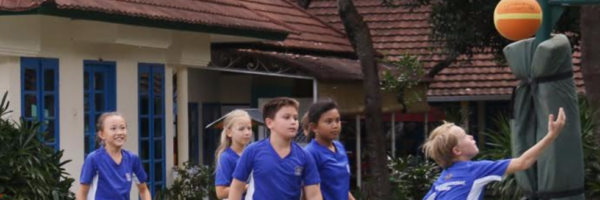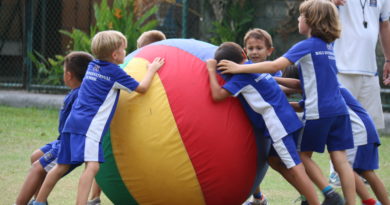Primary – Developing Motor Skills
Throughout every moment of the day, children need to effectively navigate their physical environment in order to experience success. This might involve moving their bodies on the playground, or their pencil on the page. At the same time, they need to have the strength and stamina to remain seated and still for lengths of time. Due to these requirements, motor skill development remains an important component for parents to be aware of, and support. Motor skills are movements of the body which require the brain, nervous system and muscles to work together.Gross motor skills involve the large muscle groups of the body, such as legs, arms and abdomen. Fine motor skills rely on the smaller muscles of the hands, wrists, and mouth. Most activities rely on the coordination of both fine and gross motor skills, and thus in a typical child, they develop at the same pace. Outlined below, is information about why motor development isimportant for the healthy development of academic skills, personal independence and self esteem, as well as ways this development can be supported at home.
Fine motor skills
Fine motor skills are small movements such as picking up a pencil or tying your shoe, eating and speaking, and involve small muscle in the fingers, toes, wrists, lips and tongue. These skills are particularly important to performing academic skills, such as writing, cutting, manipulating a track pad, and drawing. As you can imagine, fine motor skill efficiency greatly influences the quality of the academic task outcome and also the speed of task performance.
What Might Fine Motor Difficulty Look Like?
- Avoidance and/or disinterest in pencil or scissors skills
- Expressing that their hand is tired when writing
- Preferring physical activity to avoid sitting down tasks which generally involve fine motor skills
- Over-interest in passive activities such as watching TV and playing on the iPad, which don’t require fine motor skills
- Delegating drawing tasks to others
- Not persisting in the face of a challenge when cutting, gluing, writing or arts and crafts
- Overreliance on parents to get dressed and other tasks such as cleaning teeth
========================================================================
Things That Can Improve Fine Motor Skills:
Shuffling and dealing cardsone by one, Tying and lacing shoes, Tying and untying knots, Picking up coins, buttons, marbles or other miscellaneous objects Sorting objects into small containers, Picking up small items with tweezers,Taking a handful of coins, marbles, seeds, nuts, bolts, etc. and trying to drop them from your hand at one time, Holding an object in your hand and rotating it in as many directions as possible, Squeezing clay into a ball or rolling it, Crumbling a piece of paper or cloth into a small ball with one hand, Buttoning and unbuttoning buttons, Opening and closing safety pins(try making a chain), Screwing and unscrewing large and small wing nuts from bolts, Using a screwdriver in both hands and practice screwing/unscrewing various sized screws, Putting away the silverware, Playing dominoes, checkers, Scrabble, Jenga etc, Stacking checkers or coins as high as possible, Making a house of cards, Craft projects: beading, sewing, weaving, woodwork, model kits, knitting, etc., Locking and unlocking doors,Unscrewing lids of jars,Turning a door handle, Pouring water into a cup, Writing and typing, Making collages with small items like rice and small pieces of tissue paper
Adapted from Department of Education and Training, Learn to Move Programme
========================================================================
Gross Motor Skills
Gross motor movements use the large muscles of the body and involve activities such as walking, jumping, swimming and even just sitting. Gross motor skills are obviously important for self care and recreation, but they also play a crucial role in academics. During the school day, a student needs to be able to maintain appropriate posture at their table or desk, in order to participate in the many fine motor tasks they need to accomplish throughout the school day, such as writing, cutting, drawing and typing. Gross motor development has a big impact on a child’s ability to cope with the duration of the school day which requires periods of sitting and moving between and within classrooms, and navigating the playground. Without adequate gross motor skills a child may become frustrated and feel burdened by the many physical tasks required throughout the day.
What might gross motor difficulty look like?
- Avoidance or disinterest in physical tasks
- Rush through physical tasks, to disguise difficulty or fatigue
- Poor Posture, slumping
- Silly behaviors during physical tasks they find challenging
- Frequently delegating physical tasks to others withoutactively engaging themselves
- Poor coordination in sport
========================================================================
Things that Improve Gross Motor Skills:
Balancing Activities:Walking along a narrow beam or line marked on the ground – forwards, backwards, sideways, Standing on one leg – if unable to balance, you can put one foot on a phone bookor try picking up marbles with one foot while standing on the other and placing them into container! Stepping up and down or from one box/bucket to another, Walking along different surfaces – for example pillows, foam, mattresses, Walking on toes and on heels, Follow a wriggly line – walk on line or feet on either side, Stepping over rungs of a (horizontal) ladder or on the rungs or along the edges
JumpingActivities: Jump on spot, jump forwards from a line two feet together, Jump over progressively higher stick/bar/obstacle, Jump down from a progressively higher height, Jump from hoop to hoop, circle to circle, over a rope – stationary or moving (snakes), Jump sideways – back and forth, forwards and back, Hop on spot or hop forwards progress to hopping sideways,Hopscotch, jump rope, four square
General Strength: Tug of war games (upper limb and core strength) • Wheelbarrows – walking on hands while feet are held (legs straight) (upper limb strength), Outdoor Activities, Yoga, Surfing, Swimming, Running
Motor Planning: Obstacle courses, climbing and negotiating playground equipment, Visual copy games like follow the leader, Verbal copy games such as Simon Says, Statues and Freeze Games, Bouncing on a trampoline, Galloping and skipping, skip with a rope, Dancing
(Adapted from Department of Education and Training, Learn to Move Programme)
========================================================================
References
“Gross Motor Development Chart.” Kid Sense Child Development. Kid Sense Child Development Corporation, 2017.Web. 14 Mar. 2017.
“Gross Motor Skills.” Encyclopedia of Children’s Health. Advameg, Inc., 2017. Web. 14 Mar. 2017.
Han-Son, Mary Says, and Amarjit Kaur Says. “Promote Fine Motor Skills with 30 Materials & Activities, Hands On: As We Grow.” Hands On As We Grow. N.p., 19 Dec. 2016. Web. 14 Mar. 2017.
“Mobile Physiotherapy Service In Liverpool.” The British Medical Journal 1.4500 (1947: 462: Learn To Move / Learn To Move. Queensland Government. Web.
“OT Questions- Occupational Therapy Board Review” OT Questions. N.p., n.d. Web. 14 Mar. 2017.
Jessica Bates
Learning Support Specialist



